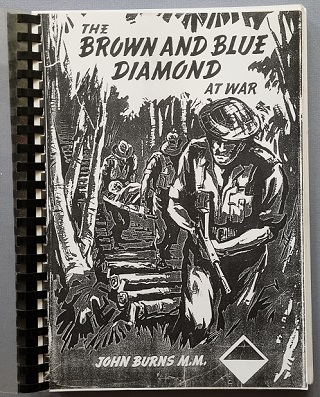Description
Title: The Brown and Blue Diamond at War – Story of the 2/27th Battalion
Author: Burns, John
Condition: Near Mint
Edition: 2nd Edition
Publication Date: 1980s
ISBN: N/A
Cover: Soft Cover without Dust Jacket (spiral bound) – 260 pages
Comments: The history of the 2/27th Infantry Battalion during World War Two.
The headquarters of the 2/27 Battalion opened for the first time at Woodside in South Australia on 7 May 1940. On 19 October the battalion left Woodside, by train, for Melbourne where ti sailed for overseas on 21 October. After a brief stop in India en-route, the 2/27th disembarked in Egypt on 24 November and moved straight to Palestine to complete its training.
As part of the 21st Brigade of the 7th Australian Division, the 2/27th’s first operational assignment of war was to bolster the defences along the Egypt–Libya frontier against an expected German attack. It occupied positions at Maaten Bagush and Matruh throughout much of April and May 1941, before returning to Palestine in preparation for its first offensive operation – the invasion of Syria and Lebanon, which began on 8 June.
The 2/27th was employed in the drive north along the Lebanon coast but most of its operations were outflanking moves in the hills that edged the coastal plain. Its major actions were at Adloun on 11 June, Miyeoumiye on 13–14 June and around El Boum, as part of the battle of Damour, between 6 and 9 July. After the armistice of 12 July, the 2/27th remained in Lebabnon as part of the Allied garrison until 11 January 1942.
After sailing from Egypt on 30 January 1942, the 2/27th disembarked in Adelaide on 24 March. The battalion’s stay in Australia, however, was brief. On 14 August it arrived at Port Moresby in Papua, and by 6 September it was in position at Mission Ridge on the Kokoda Trail preparing to meet the relentless advance of the Japanese. The battalion held on to its positions for two days before being forced to pull out by a Japanese outflanking move that cut the Trail behind it. A grim 2 week withdrawal through the jungle, with little food, followed. Sick and exhausted, the 2/27th rejoined the main Australian force at Jawarere, 40 kilometres east of Port Moresby, on 22 September.
After a period of rest and retraining the 2/27th returned to action at Gona on 28 November. It suffered heavily in series of rushed and ill-conceived attacks and was further assailed by the ravages of tropical disease. By the time it was relived on 6 January 1943, it was only 70 strong.
The 2/27th returned to Australian in mid-January but was back in Papua by early August. It spent a month training near Port Moresby before being flown to Kaipit in New Guinea to take part in the advance along the Ramu Valley. Leaving Kaipit on 29 September, the 21st Brigade reached Dumpu on 4 October and then began pushing up into the Finisterre Ranges. The 2/27th occupied several key features during these operations and bore the brunt of the one major counterattack launched by the Japanese on 12 October. Thereafter,the 2/27th’s operations were prinicipally patrol actions. It began returning to Port Moresby on 3 January 1944, and arrived back in Australia on 1 March.
The 2/27th left Australia for its last operation of the war on 3 June 1945. The battalion landed at Balikpapan on 1 July and after the attacks of that day, conducted with relatively light casualties, its operations were confined mainly to small-scale patrolling until the end of the war on 15 August. From mid-October to late January 1946 the 2/27th formed part of the occupation force in the Celebes. It sailed for home for the last time on 4 February, arrived at Brisbane on 14 February, and was disbanded there on 18 March.
Includes Nominal Roll





